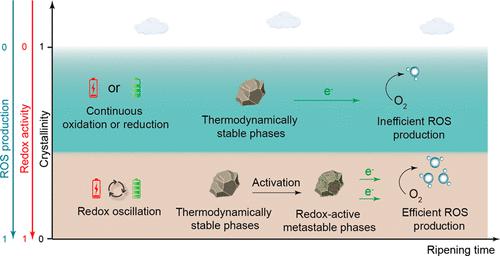当前位置:
X-MOL 学术
›
Environ. Sci. Technol.
›
论文详情
Our official English website, www.x-mol.net, welcomes your feedback! (Note: you will need to create a separate account there.)
Redox Oscillations Activate Thermodynamically Stable Iron Minerals for Enhanced Reactive Oxygen Species Production
Environmental Science & Technology ( IF 10.8 ) Pub Date : 2023-05-30 , DOI: 10.1021/acs.est.3c02302 Guoqiang Zhao 1, 2 , Mengxi Tan 1 , Binbin Wu 1 , Xiaoshan Zheng 1 , Ruoxuan Xiong 1 , Baoliang Chen 1, 2 , Andreas Kappler 3, 4 , Chiheng Chu 1, 2
Environmental Science & Technology ( IF 10.8 ) Pub Date : 2023-05-30 , DOI: 10.1021/acs.est.3c02302 Guoqiang Zhao 1, 2 , Mengxi Tan 1 , Binbin Wu 1 , Xiaoshan Zheng 1 , Ruoxuan Xiong 1 , Baoliang Chen 1, 2 , Andreas Kappler 3, 4 , Chiheng Chu 1, 2
Affiliation

|
Reactive oxygen species (ROS) play key roles in driving biogeochemical processes. Recent studies have revealed nonphotochemical electron transfer from redox-active substances (e.g., iron minerals) to oxygen as a new route for ROS production. Yet, naturally occurring iron minerals mainly exist in thermodynamically stable forms, restraining their potential for driving ROS production. Here, we report that tide-induced redox oscillations can activate thermodynamically stable iron minerals for enhanced ROS production. •OH production in intertidal soils (15.8 ± 0.5 μmol/m2) was found to be 5.9-fold more efficient than those in supratidal soils. Moreover, incubation of supratidal soils under tidal redox fluctuations dramatically enhanced •OH production by 4.3-fold. The tidal hydrology triggered redox alternation between biotic reduction and abiotic oxidation and could accelerate the production of reactive ferrous ions and amorphous ferric oxyhydroxides, making thermodynamically stable iron minerals into redox-active metastable iron phases (RAMPs) with reduced crystallinity and promoting surface electrochemical activities. Those RAMPs displayed enhanced redox activity for ROS production. Investigations of nationwide coastal soils verified that tide-induced redox oscillations could ubiquitously activate soils for enhanced ROS production. Our study demonstrates the effective formation of RAMPs from redox oscillations by hydrological perturbations, which provides new insights into natural ROS sources.
中文翻译:

氧化还原振荡激活热力学稳定的铁矿物质,以增强活性氧的产生
活性氧(ROS)在驱动生物地球化学过程中发挥着关键作用。最近的研究表明,从氧化还原活性物质(例如铁矿物)到氧气的非光化学电子转移是产生 ROS 的新途径。然而,天然存在的铁矿物质主要以热力学稳定的形式存在,限制了它们驱动活性氧产生的潜力。在这里,我们报告潮汐引起的氧化还原振荡可以激活热力学稳定的铁矿物质,从而增强活性氧的产生。•潮间带土壤中的 OH 生成效率 (15.8 ± 0.5 μmol/m 2 ) 比潮上土壤中的 OH 生成效率高 5.9 倍。此外,潮汐氧化还原波动下潮上土壤的孵化显着增强•OH产量增加4.3倍。潮汐水文触发了生物还原和非生物氧化之间的氧化还原交替,可以加速活性亚铁离子和无定形羟基氧化铁的产生,使热力学稳定的铁矿物转化为结晶度降低的氧化还原活性亚稳态铁相(RAMP),并促进表面电化学活性。这些 RAMP 显示出增强的 ROS 产生氧化还原活性。对全国沿海土壤的调查证实,潮汐引起的氧化还原振荡可以普遍激活土壤,从而增强活性氧的产生。我们的研究证明了水文扰动导致的氧化还原振荡可以有效形成 RAMP,这为了解天然 ROS 来源提供了新的见解。
更新日期:2023-05-30
中文翻译:

氧化还原振荡激活热力学稳定的铁矿物质,以增强活性氧的产生
活性氧(ROS)在驱动生物地球化学过程中发挥着关键作用。最近的研究表明,从氧化还原活性物质(例如铁矿物)到氧气的非光化学电子转移是产生 ROS 的新途径。然而,天然存在的铁矿物质主要以热力学稳定的形式存在,限制了它们驱动活性氧产生的潜力。在这里,我们报告潮汐引起的氧化还原振荡可以激活热力学稳定的铁矿物质,从而增强活性氧的产生。•潮间带土壤中的 OH 生成效率 (15.8 ± 0.5 μmol/m 2 ) 比潮上土壤中的 OH 生成效率高 5.9 倍。此外,潮汐氧化还原波动下潮上土壤的孵化显着增强•OH产量增加4.3倍。潮汐水文触发了生物还原和非生物氧化之间的氧化还原交替,可以加速活性亚铁离子和无定形羟基氧化铁的产生,使热力学稳定的铁矿物转化为结晶度降低的氧化还原活性亚稳态铁相(RAMP),并促进表面电化学活性。这些 RAMP 显示出增强的 ROS 产生氧化还原活性。对全国沿海土壤的调查证实,潮汐引起的氧化还原振荡可以普遍激活土壤,从而增强活性氧的产生。我们的研究证明了水文扰动导致的氧化还原振荡可以有效形成 RAMP,这为了解天然 ROS 来源提供了新的见解。














































 京公网安备 11010802027423号
京公网安备 11010802027423号